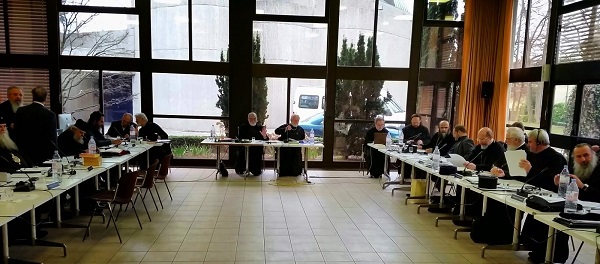An ecclesiological approach on the road to the Holy and Great Synod – 3
17 January 2016[Previous Publication: http://bit.ly/1W9QZQF]
Of course, the text of the 5th Pre-Synod Meeting retained the core of the thinking of the 3rd, though did not proceed to any analytical critical evaluation of the progress and particular problems of all the bilateral discussions, as the 3rd Pan-Orthodox Conference had done. This point represents a deficiency, since thirty years of discussions had elapsed since the 3rd Pre-Synod and it would have been useful to take stock of the various components, achieved and pending, even if these are not referred to the Holy and Great Synod, because the talks are still under way. As regards this, in my opinion, neither dimension of the discussions, the multilateral or the bilateral, can be regarded as successful, because the methodology is different and because participation in multilateral talks and the institutional organs of the Ecumenical Movement involves cooperation on a practical level and the participation in multipartite activity in the fields of evangelizing, service, theological education, inter-religious dialogues, and the common Christian witness on justice, peace and the preservation of the environment: what was called in the Pan-Orthodox texts of the 60s and 70s the ‘horizontal line’.
Be that as it may, as has already been noted above it is positive that the fullest fruits and the framework of principles of the 3rd Pre-Synod Meeting have been retained, with certain supplements and addenda, which are a correct response to the most recent developments in the Ecumenical Movement and within Orthodoxy itself.
The most hopeful aspect is that the text submitted has given rise to opportunities for a deeper investigation of Orthodox ecclesiology, especially the study of the canonical criteria regarding the limits of the Orthodox tradition of the Church. This was already the desideratum as early as the 3rd Pre-Synod Meeting, because there was the conviction that it would allow a unified stance to be maintained by all the local Orthodox Churches during any discussion of ecclesiological texts. And something even more important. Since ecclesiology is the core of ecumenical deliberations and particular attention is paid to it in all discussions, an effort began to take shape from as early as the 70s, on a Pan-Orthodox level, to utilize the ecclesiological teaching of the Orthodox Church not only for a deeper understanding of its own consciousness, but also for a responsible evaluation of the form of ecclesiasticity of the Christian world which exists outside it, but which lives next to it and with it.
Irrespective of the final evaluation of the theological discussions, the Orthodox Church has managed not only to avoid categorizing Christendom into schismatic or heretical communities which are threatening it, but in the text ‘Relations between the |Orthodox Church and the rest of the Christian world’, from the 3rd Pre-Synod Meeting, it stated unanimously that: ‘The Orthodox Church, as the One, Holy Catholic and Apostolic Church, is fully aware of its responsibilities regarding the unity of the Christian world, recognizes the actual existence of all Christian churches and confessions, and also believes that relationships with them should be based, as far as possible, on the swiftest and most objective clarification of their teaching on the sacraments, grace, the priesthood, and the Apostolic succession’.
The above position, which is the most official attempt so far on a Pan-orthodox level to define the ecclesiological identity of the Orthodox Church with reference to the identity of the other Christian Churches and Confessions first took shape, in 1971, at the Inter-Orthodox Preparatory Commission for the Preparation of the Holy and Great Synod, in the extremely interesting text: ‘Dispensation in the Orthodox Church’.
In relation to this position, the then head of the Secretariat for the preparation of the Holy and Great Synod, Metropolitan Damaskinos of Switzerland posed a number of exceptionally sensitive and imperative questions. I shall mention no more than two of these: What is the ecclesiological basis on which the Orthodox found their unifying efforts with other Churches which confess the same faith in Jesus Christ as Lord and Redeemer of the world? And if the Orthodox Church understands itself to be the One, Holy, Catholic and Apostolic Church, which has preserved the apostolic faith and the tradition of the ancient Church and of the seven Ecumenical Synods unchanged, what theological view can be adopted by the future Pan-Orthodox Synod, as regards the existence of the other Christian Confessions?







